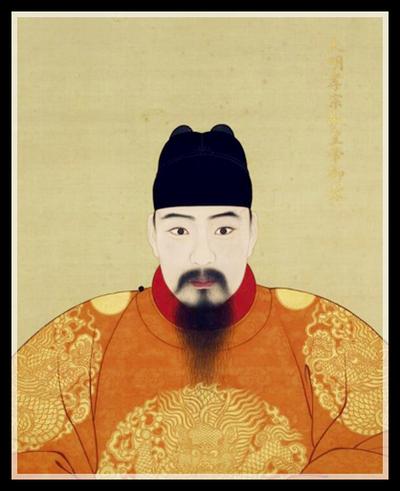
Hongzhi Emperor
| Name | Hongzhi Emperor |
| Title | 9th emperor of the Ming Dynasty (1470–1505) |
| Gender | Male |
| Birthday | 1470-07-30 |
| nationality | Ming dynasty |
| Source | https://www.wikidata.org/wiki/Q9994 |
| pptrace | View Family Tree |
| LastUpdate | 2025-10-31T07:17:22.407Z |
Introduction
The Hongzhi Emperor, born Zhu Youcheng on 30 July 1470, was the tenth emperor of the Ming dynasty in China. His reign lasted from 1487 until his death on 9 June 1505. He succeeded his father, the Chenghua Emperor, and was known for his adherence to Confucian principles and efforts to promote good governance.
Early Life and Accession:
Zhu Youcheng was the third son of the Chenghua Emperor and his mother, a woman surnamed Ji, was one of the Yao people captured during the suppression of a rebellion in Guangxi province. He inherited a southern appearance characterized by a small stature and darker complexion, with notable features including a bushy moustache and intelligent eyes. His mother died under suspicious circumstances when he was five years old, after which his grandmother, Empress Dowager Zhou, oversaw his safety. In 1475, Zhu Youcheng was officially recognized as the heir to the throne, and from a young age, he received a comprehensive Confucian education, beginning formally in 1478. His studies emphasized the teachings of the Four Books and the qualities of exemplary successors.
Transfer to the throne:
In 1487, upon the illness of the Chenghua Emperor, Zhu Youcheng was designated his successor. The Emperor died shortly thereafter, and Zhu Youcheng was crowned and adopted the era name Hongzhi, meaning "great governance." His mother was named Empress Dowager Xiaomu, and his wife, Lady Zhang from Xingji, became Empress. He was deeply devoted to his wife, and the couple had at least one son, Zhu Houzhao, who later became the Zhengde Emperor.
Reign:
The Hongzhi Emperor's administration was marked by the promotion of Confucian governance, with a focus on reducing taxes and government expenditure, appointing capable officials, and encouraging open discussions among ministers. His policies contributed to the suppression of palace intrigues and a reduction in eunuch influence, which helped restore governmental transparency. The Great Ming Code was updated during his rule, and the economy prospered despite natural disasters including droughts and floods. Notably, effective regulation of the Yellow River was achieved between 1492 and 1494 through large-scale engineering efforts.
Foreign Relations and Military:
Foreign policy during the Hongzhi era was primarily peaceful. The most significant military action was the 1495 expedition to Hami, aimed at countering Turpan influence. Ming forces temporarily captured Hami and installed a Uighur prince, but the city was recaptured by Turpan forces within the same year. The Ming government also engaged in limited actions along the Silk Road and contended with unrest in southwestern regions, such as the rebellions led by tribes in Guizhou and Hainan.
Palace Relations:
The Emperor was devoted to his wife, but her relatives, especially her brothers, gained significant influence through imperial favors and titles, often amidst accusations of corruption and embezzlement. The court was characterized by a mixture of Confucian principles and Taoist beliefs, with some officials criticizing the Emperor's religious inclinations. After ascending the throne, the Hongzhi Emperor reformed the eunuchs' influence by demoting and appointing trustworthy officials to oversee the palace's internal affairs.
Governmental Approach:
Upon his accession, the Hongzhi Emperor undertook a substantial reduction of bureaucratic ranks, dismissing officials based on merit and integrity. He held regular court audiences and sought advice from able ministers, maintaining a style of governance rooted in Confucian ideals. Despite frail health, he actively participated in debates and was committed to moral and administrative reform, emphasizing the importance of virtue and good conduct.
Cultural and Economic Developments:
During his rule, the arts flourished, particularly in Suzhou, where notable painters and calligraphers emerged. The government engaged in the tea trade and attempted to regulate currency, though privately produced coins increasingly circulated. Environmental challenges persisted, with significant floods and droughts, but efforts to manage natural disasters—such as the regulation of the Yellow River—were undertaken.
Death and Legacy:
The Hongzhi Emperor died in June 1505 after falling ill. He was posthumously titled Emperor Jing and buried in the Tai Mausoleum near Beijing. His thirteen-year-old son succeeded him as the Zhengde Emperor. Historically, the Hongzhi era is noted for its relative stability, adherence to Confucian governance, and efforts toward administrative reform. He is recognized as one of the most accomplished rulers of the Ming dynasty after the Hongwu and Yongle emperors.
Family:
The Empress Xiaochengjing of the Zhang clan bore two sons: Zhu Houzhao, who became the Zhengde Emperor, and a deceased younger son. He also had three daughters—Princess Taikang, Princess Yongfu, and Princess Yongchun—although some historical records indicate only two daughters, with others attributing their parentage to his younger brother.
Family Tree
Tap to expand more relatives